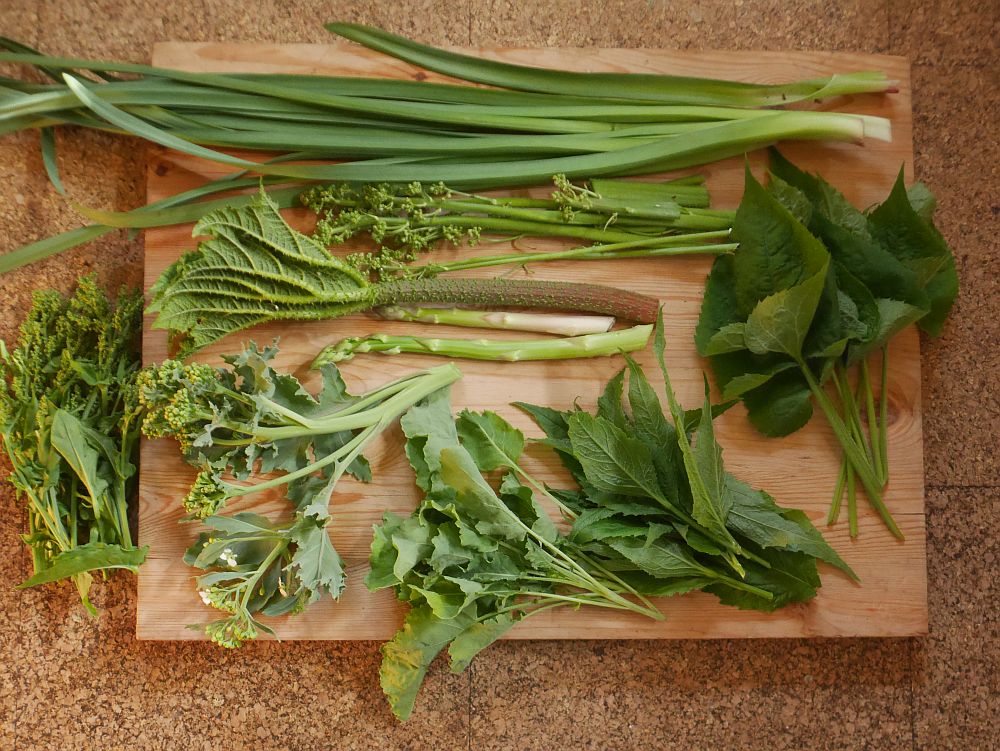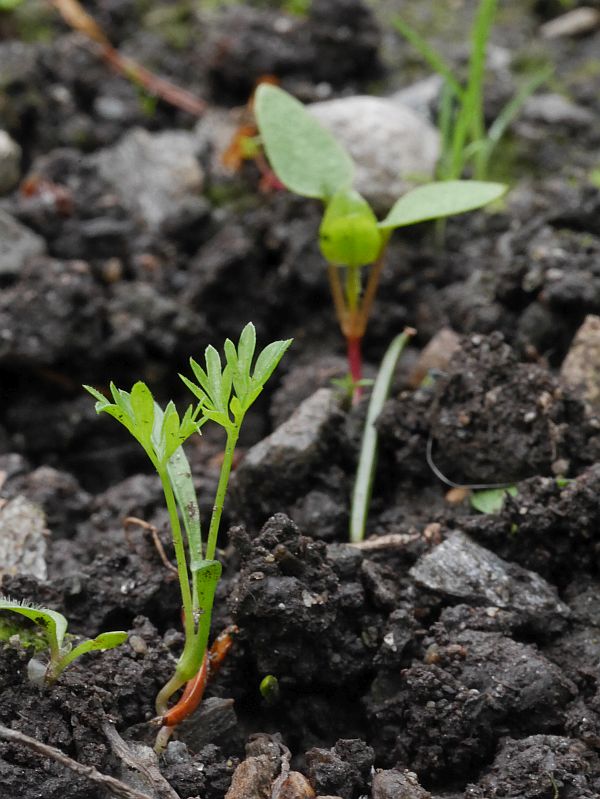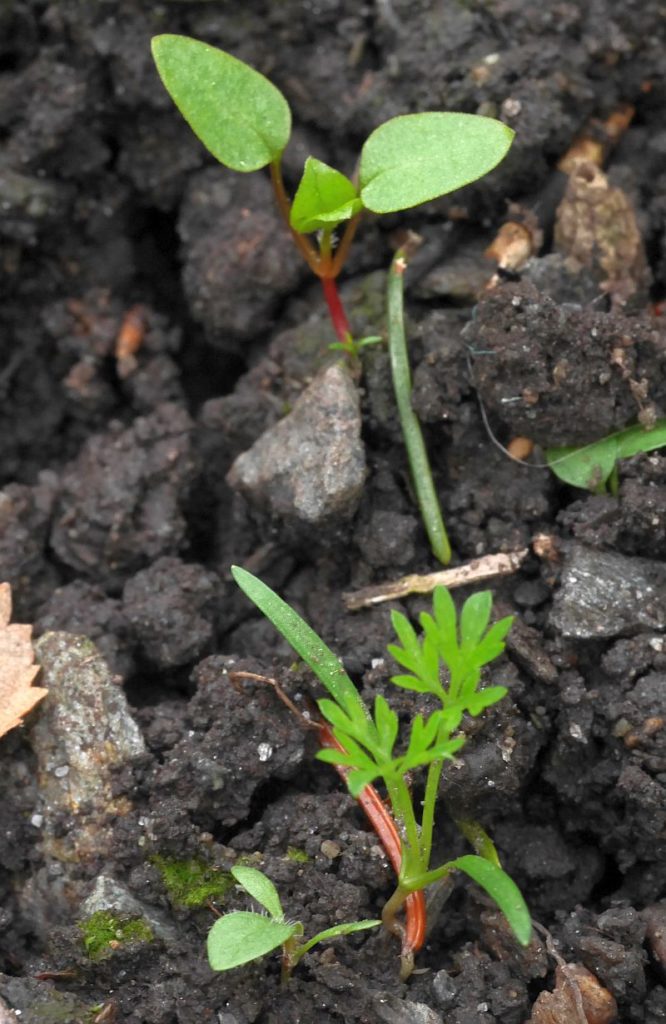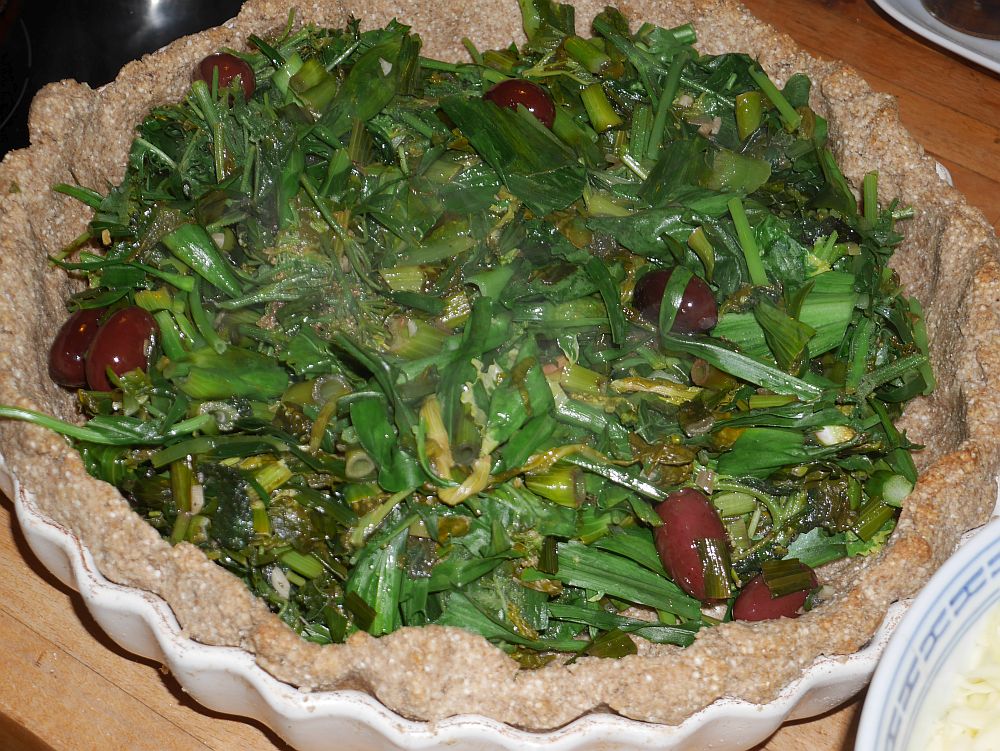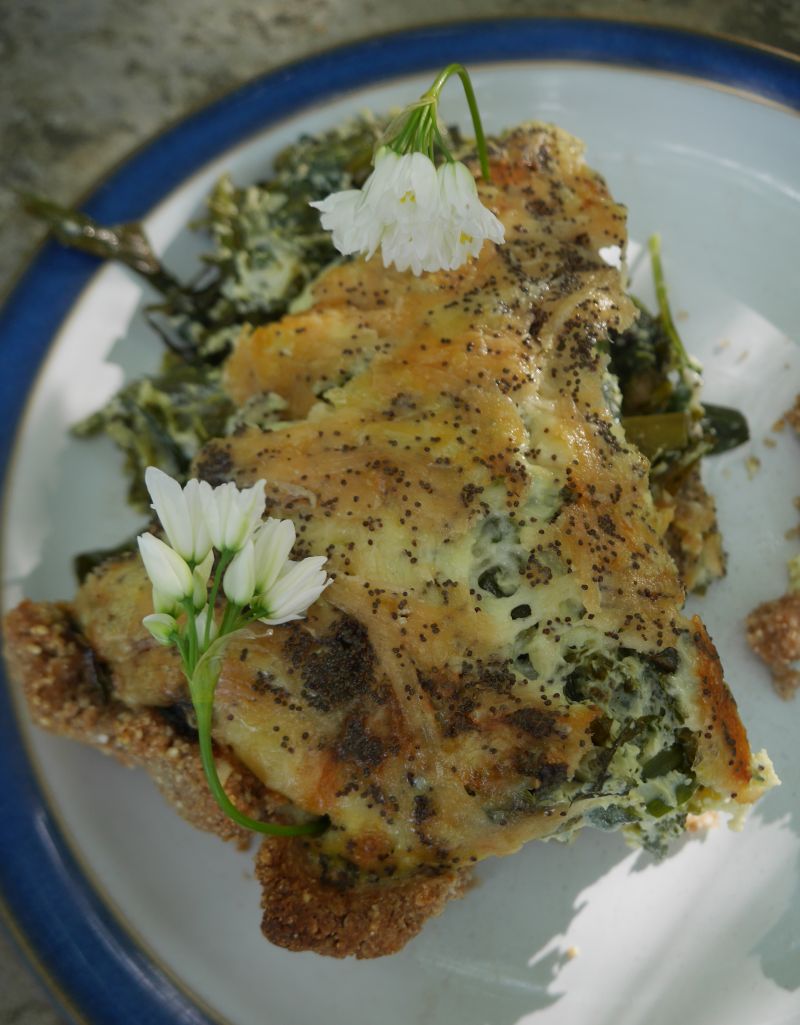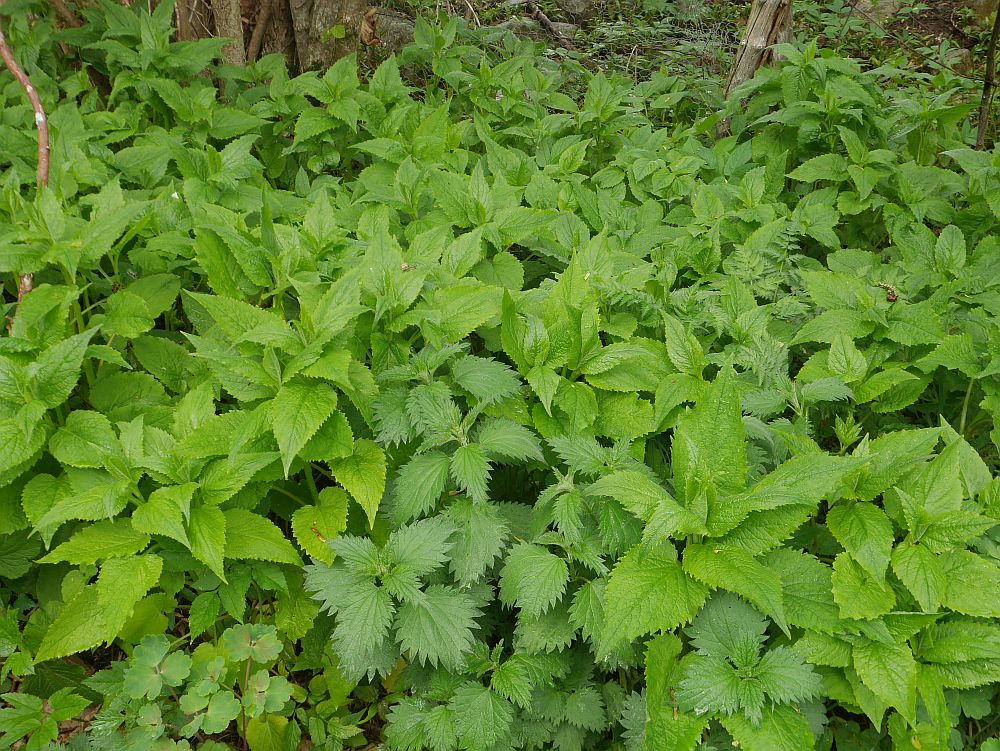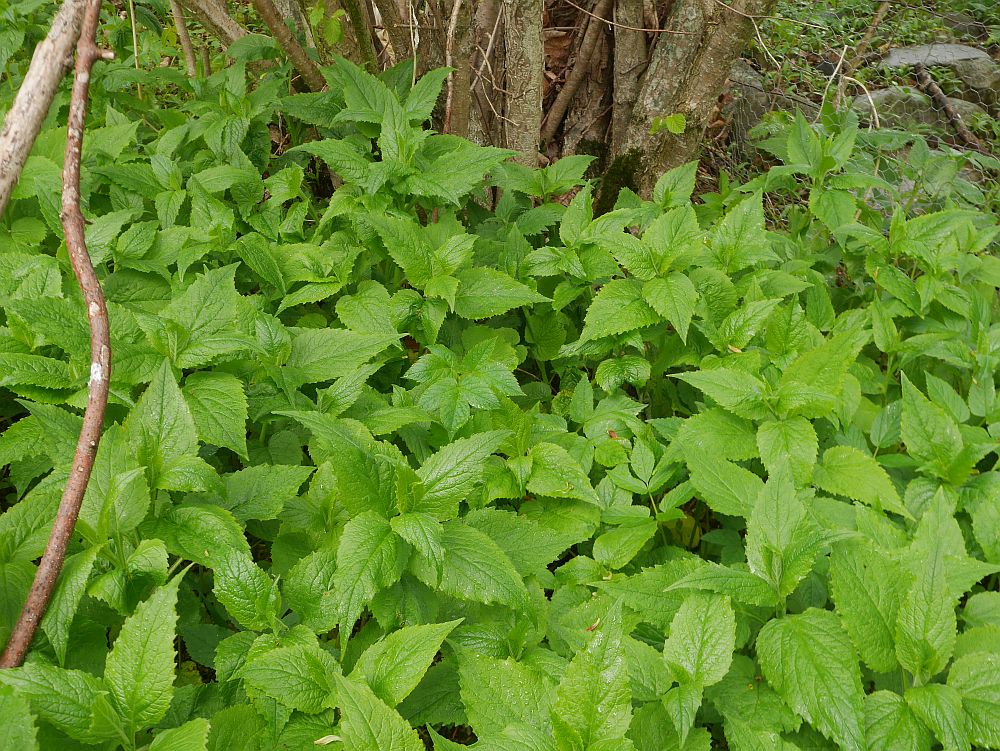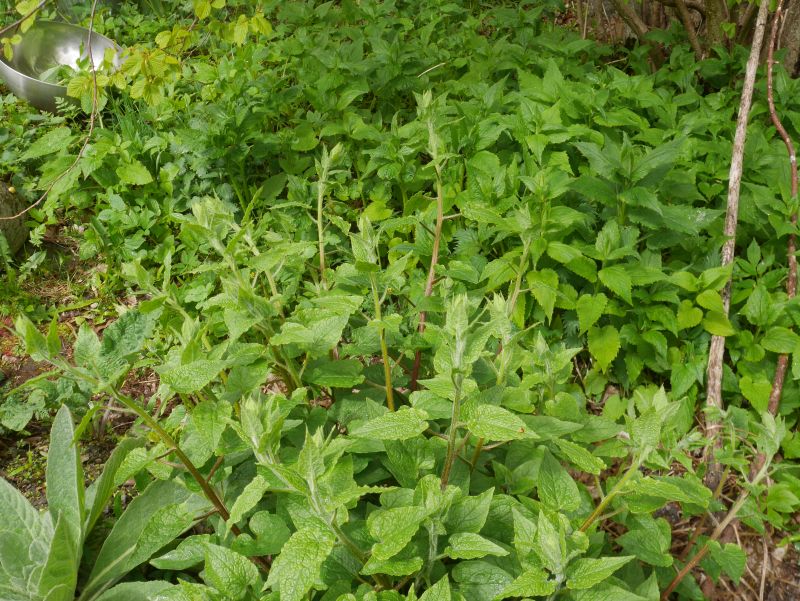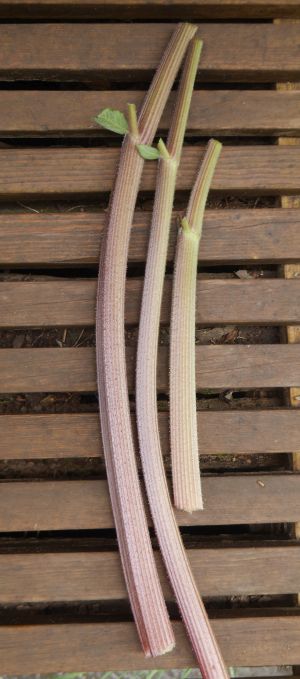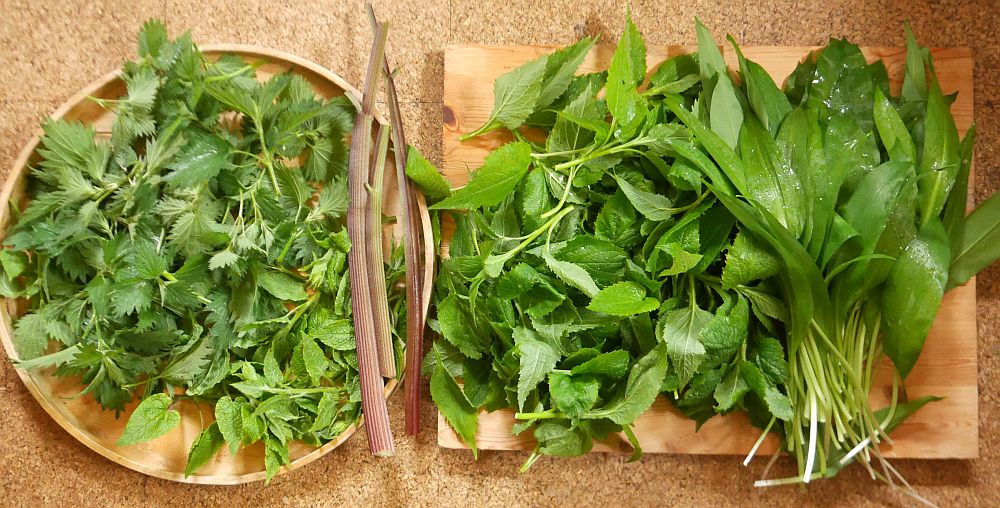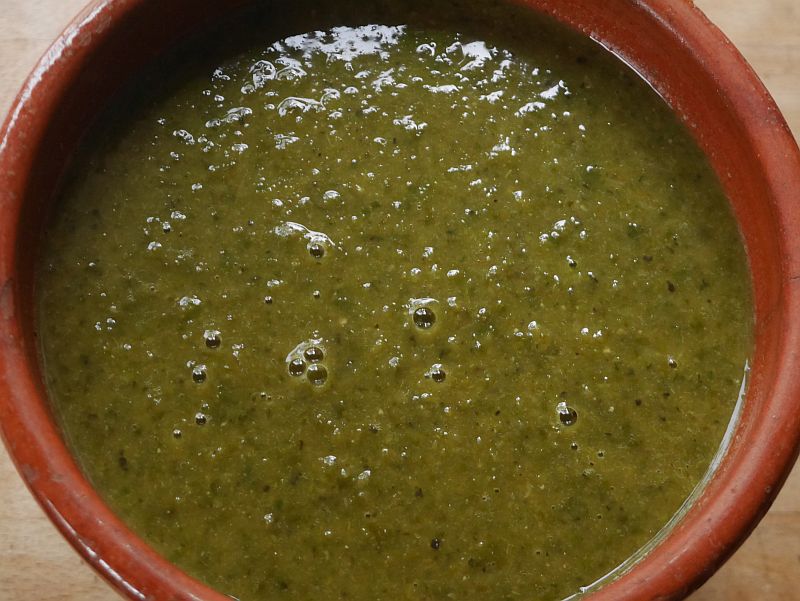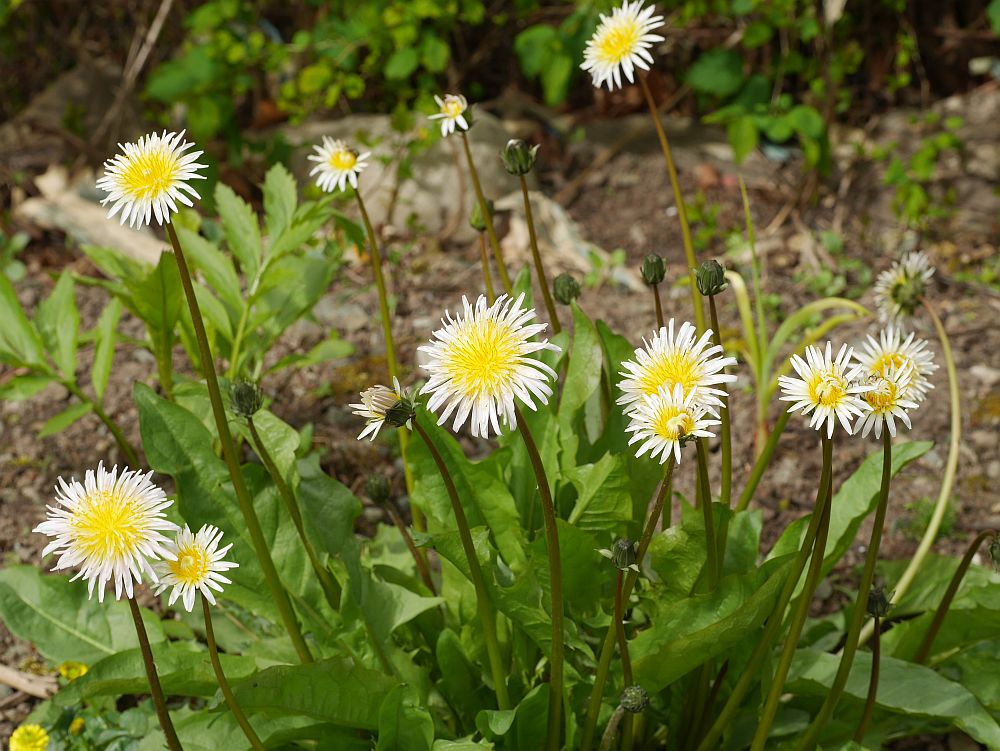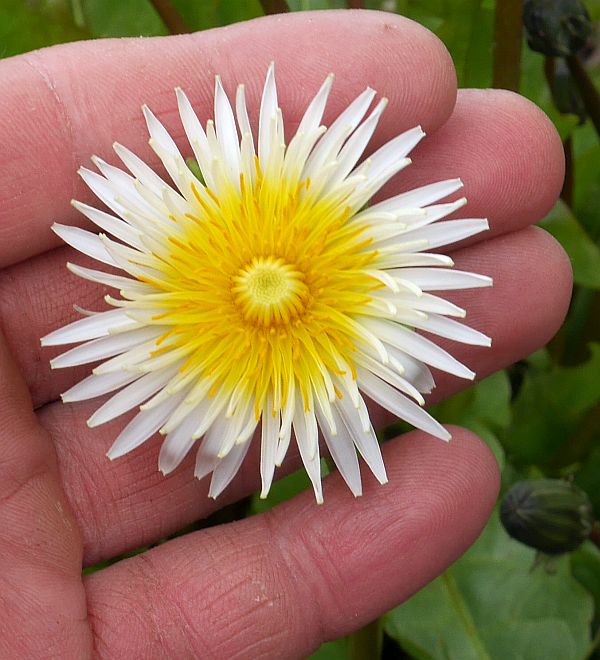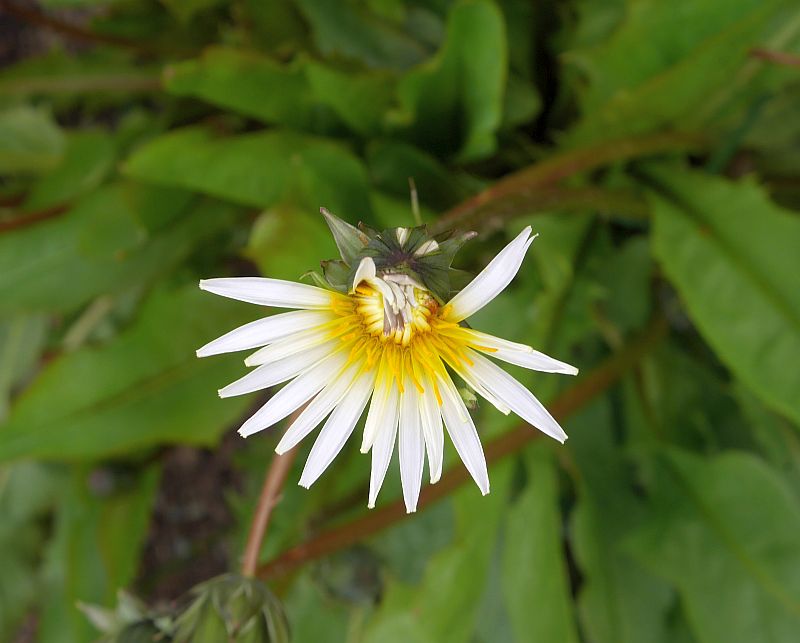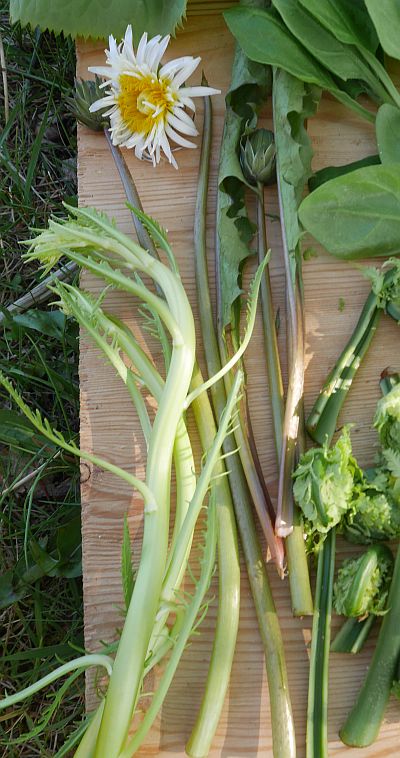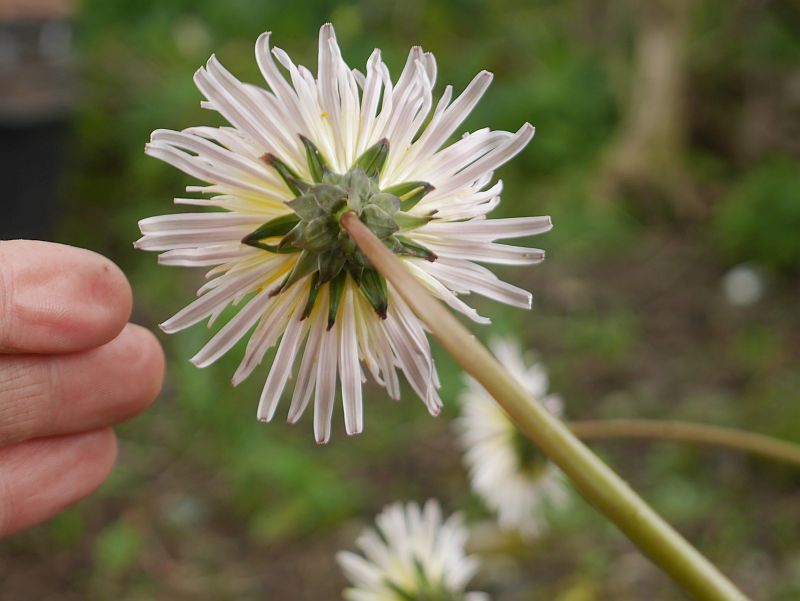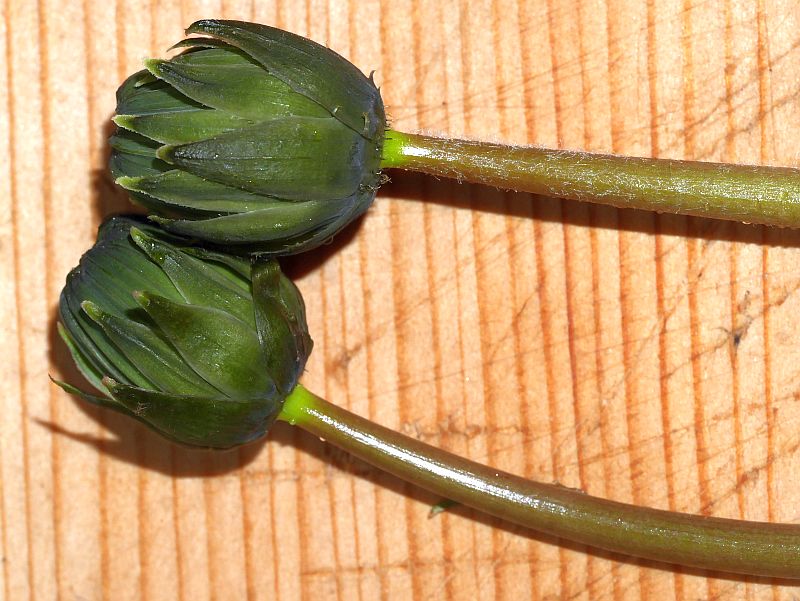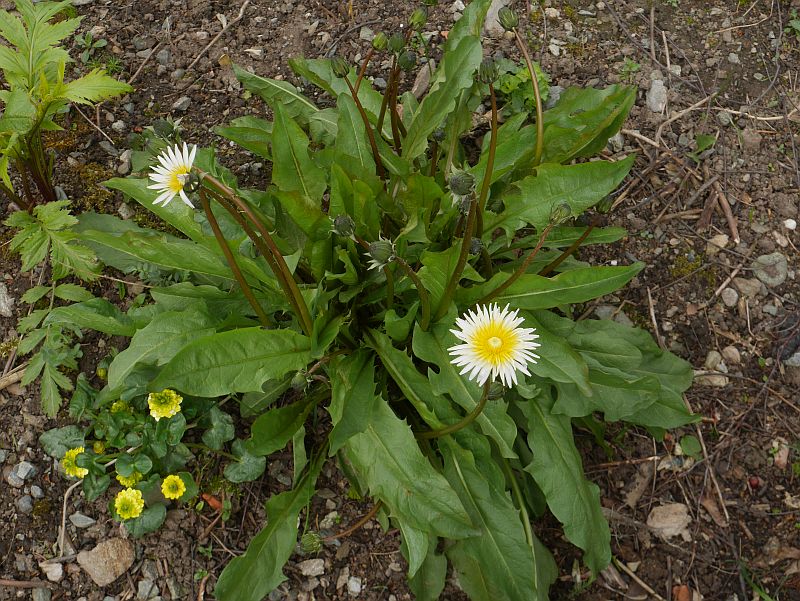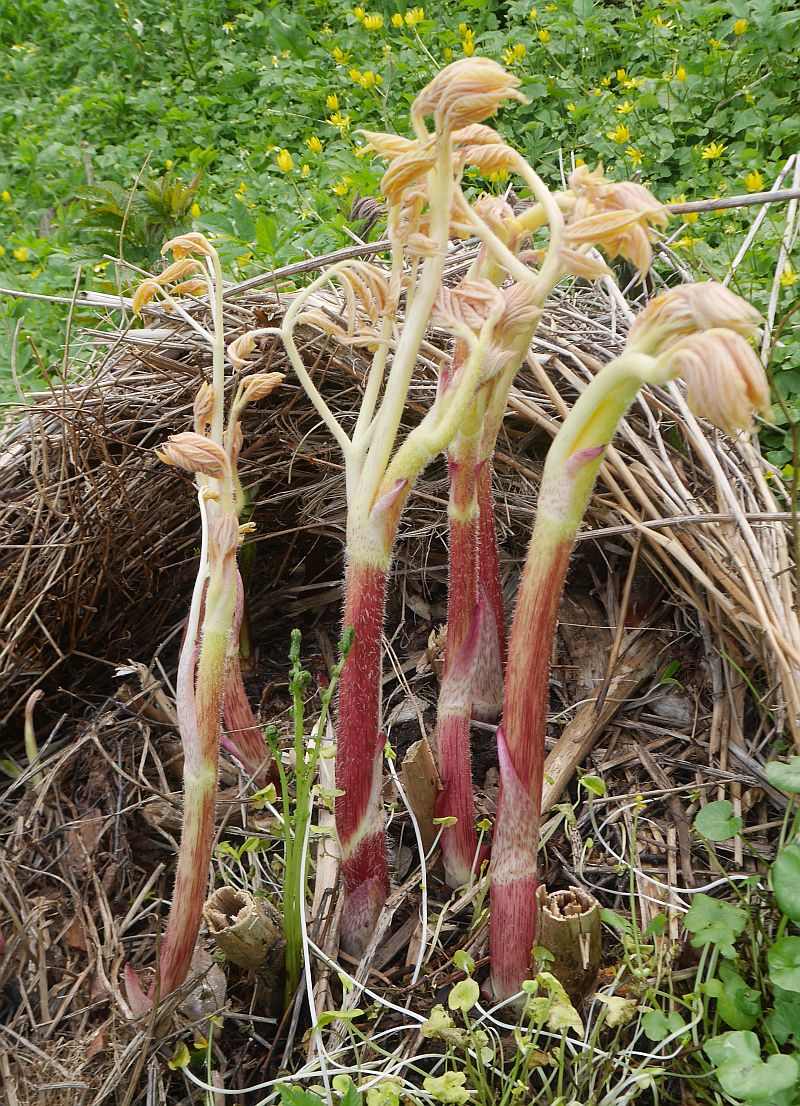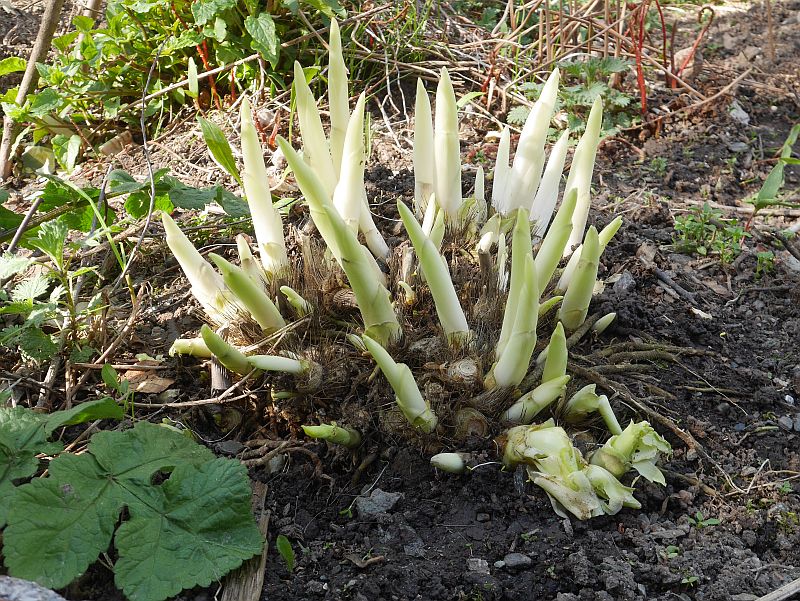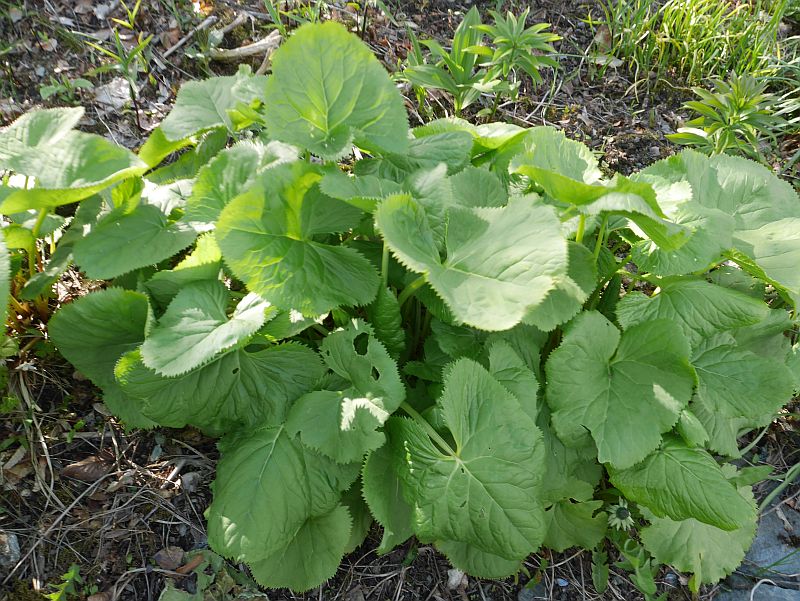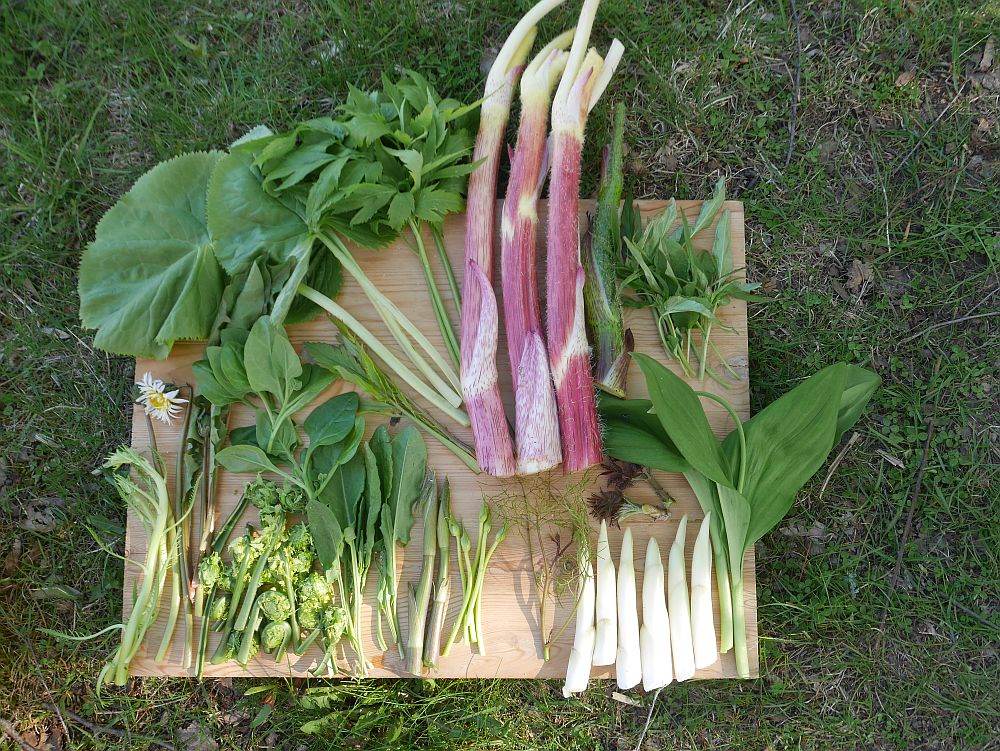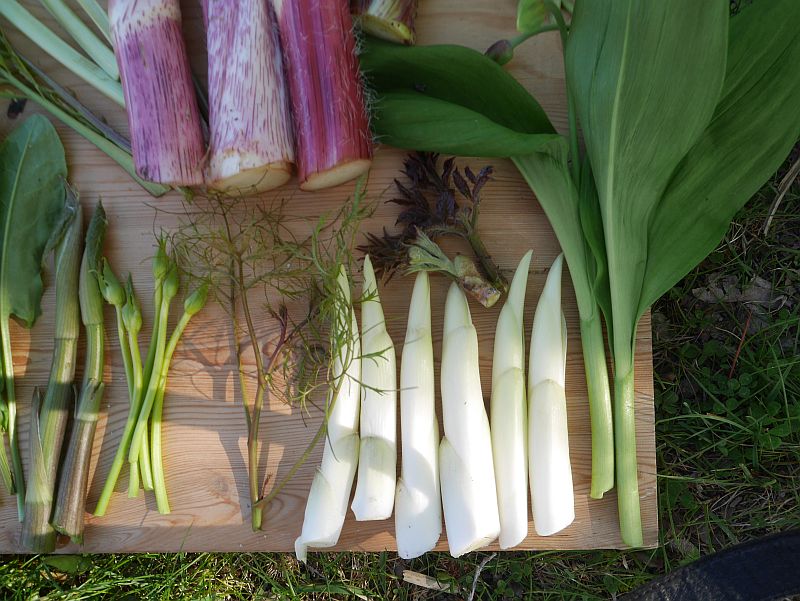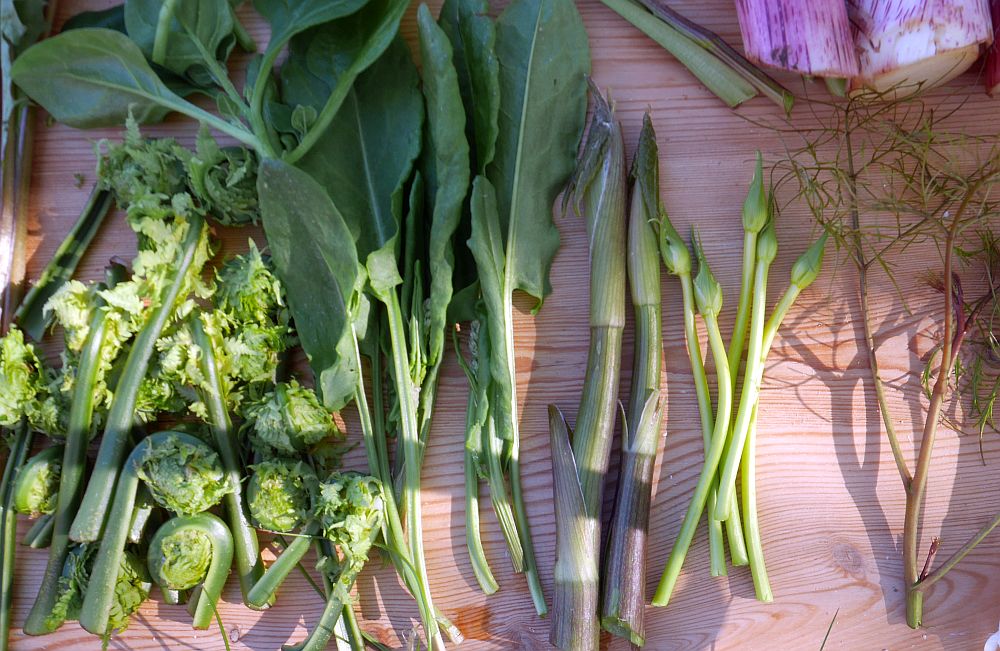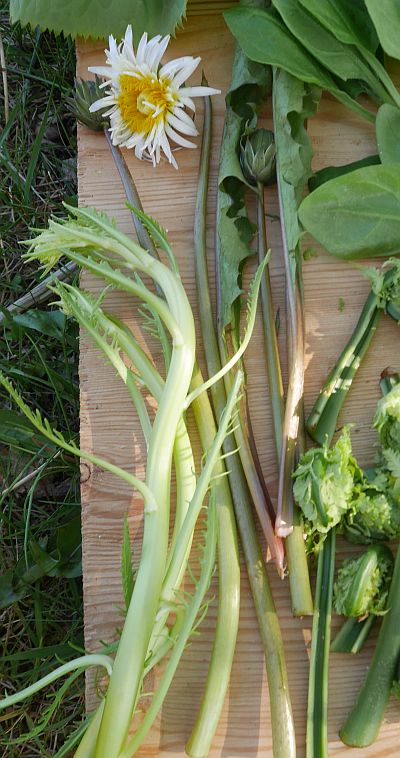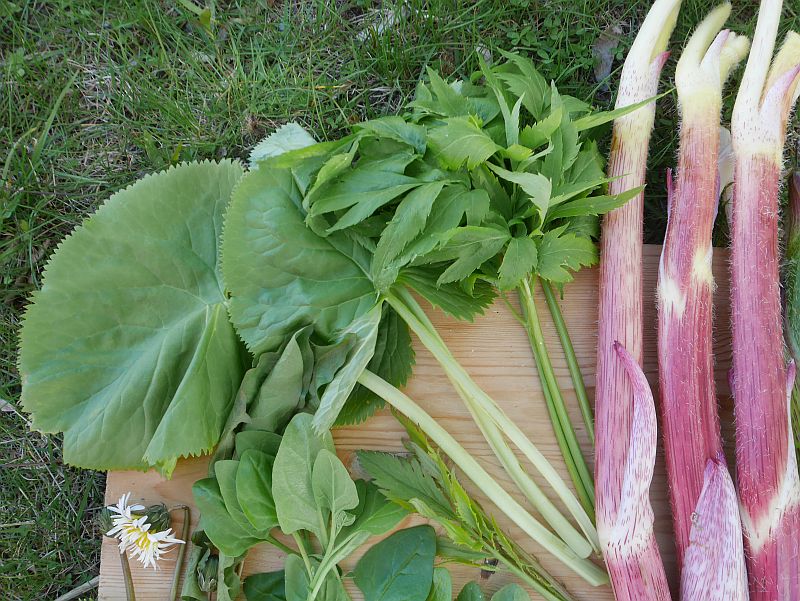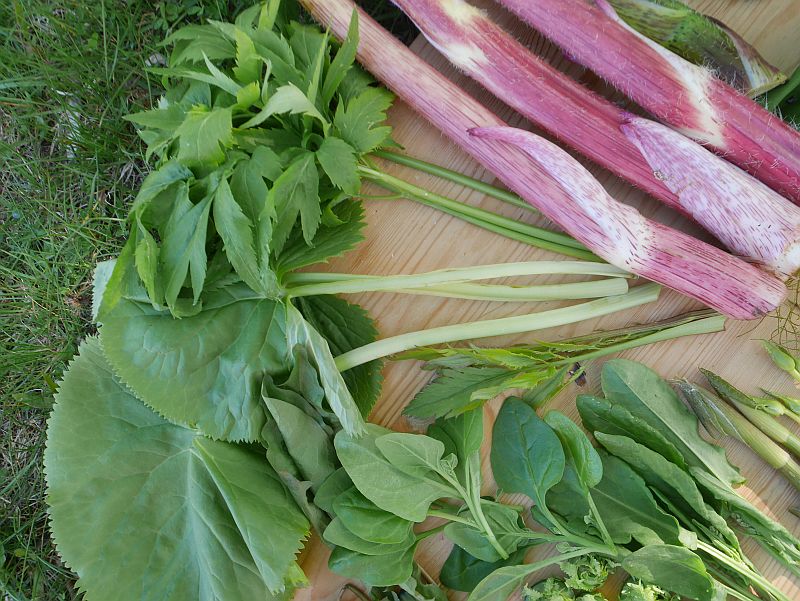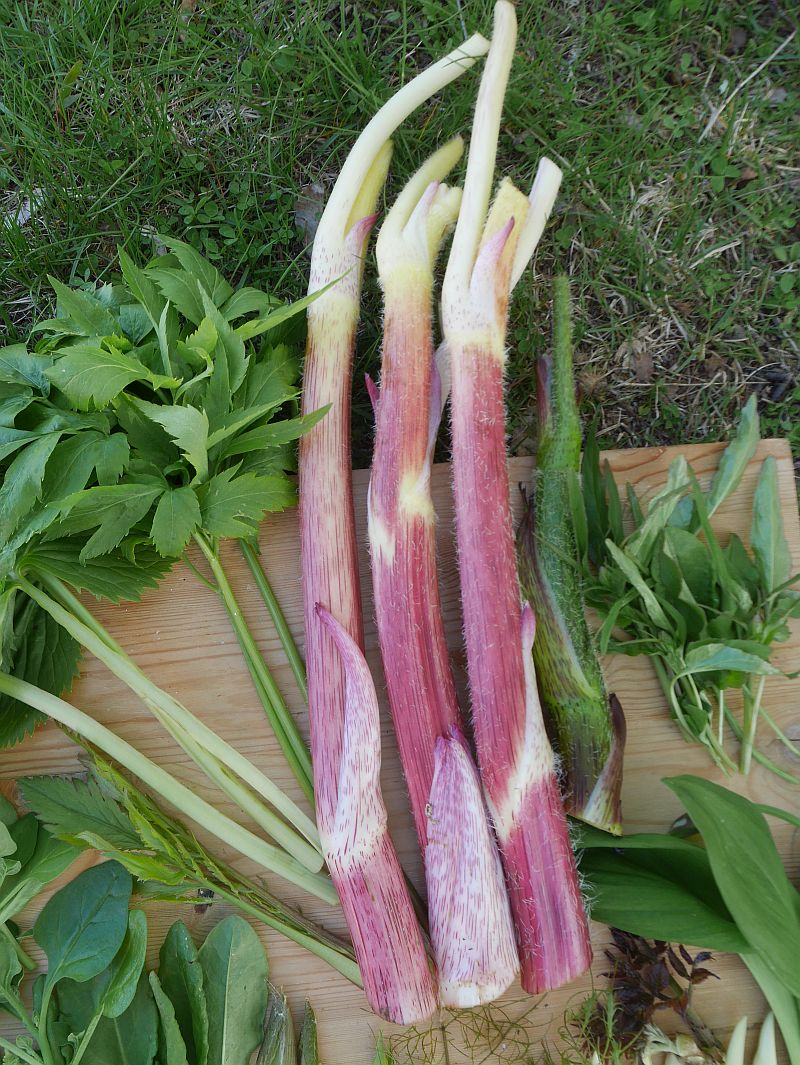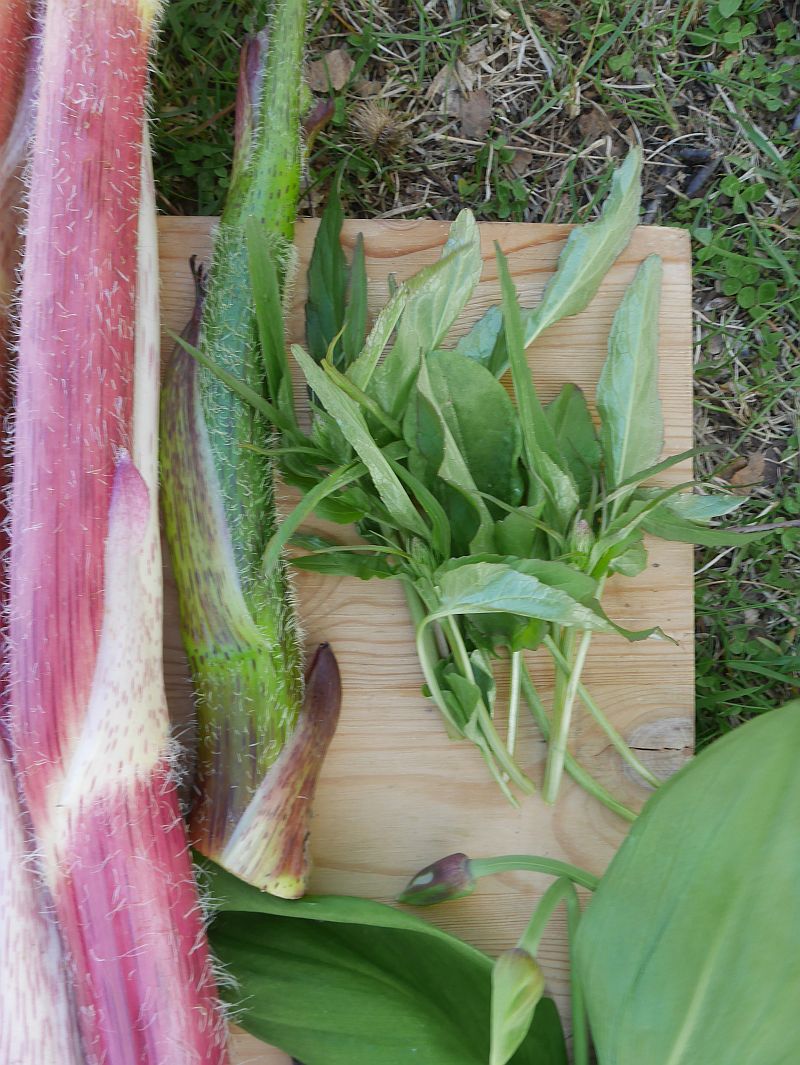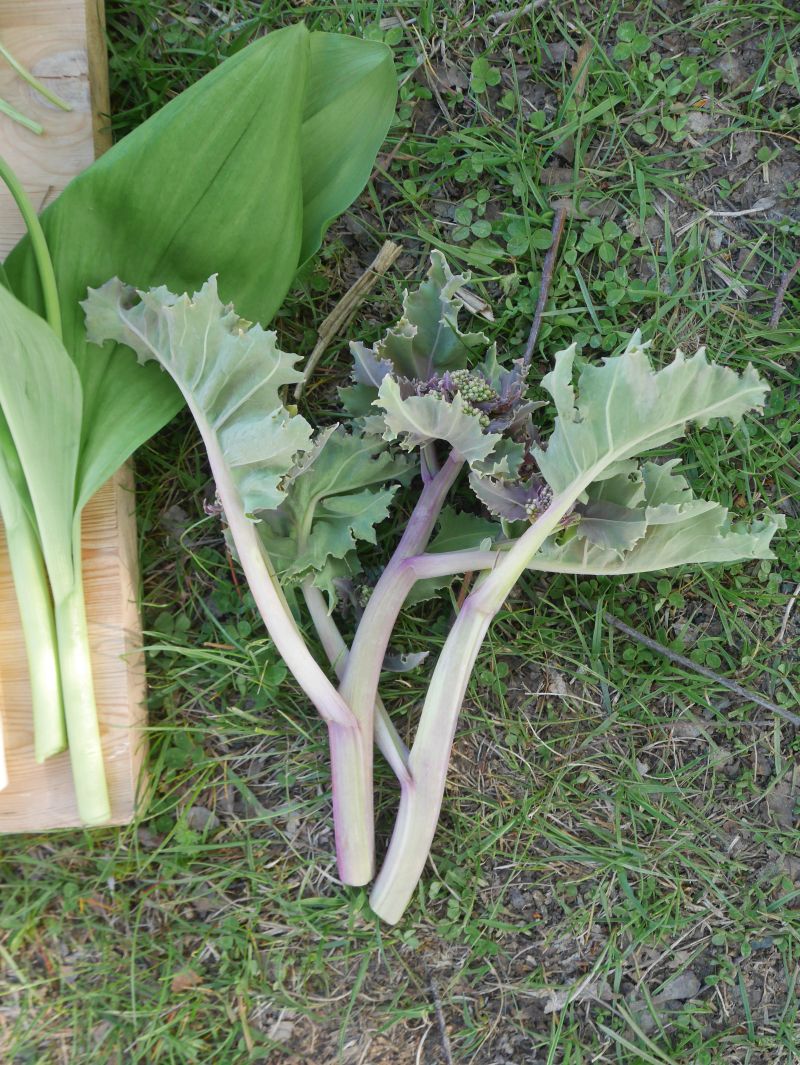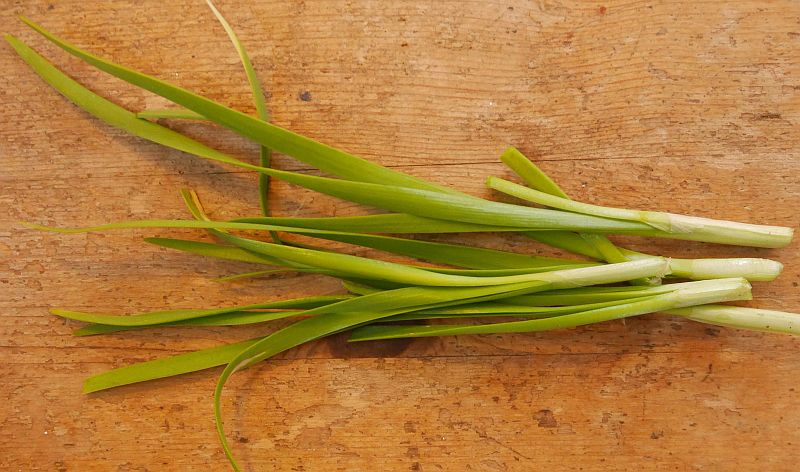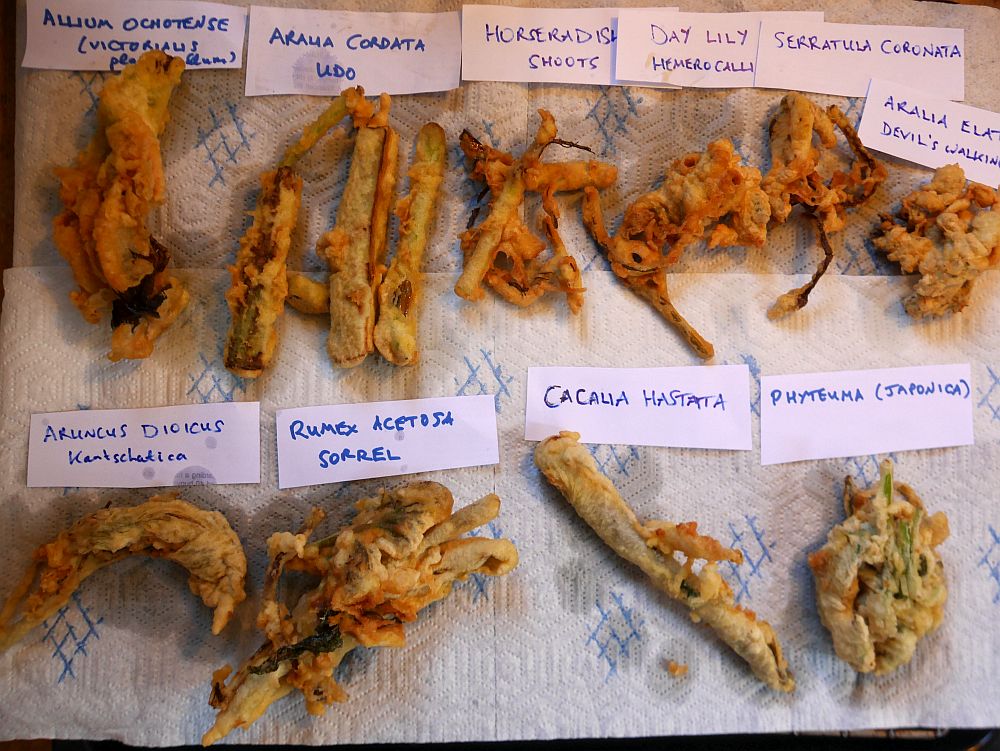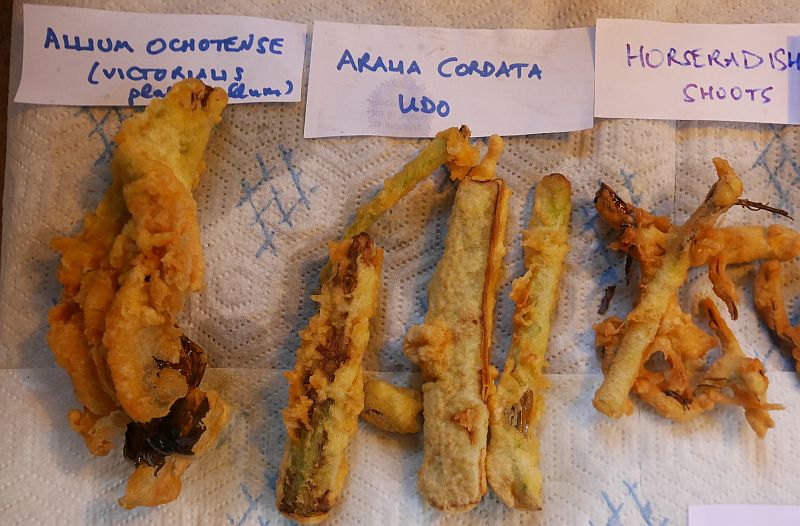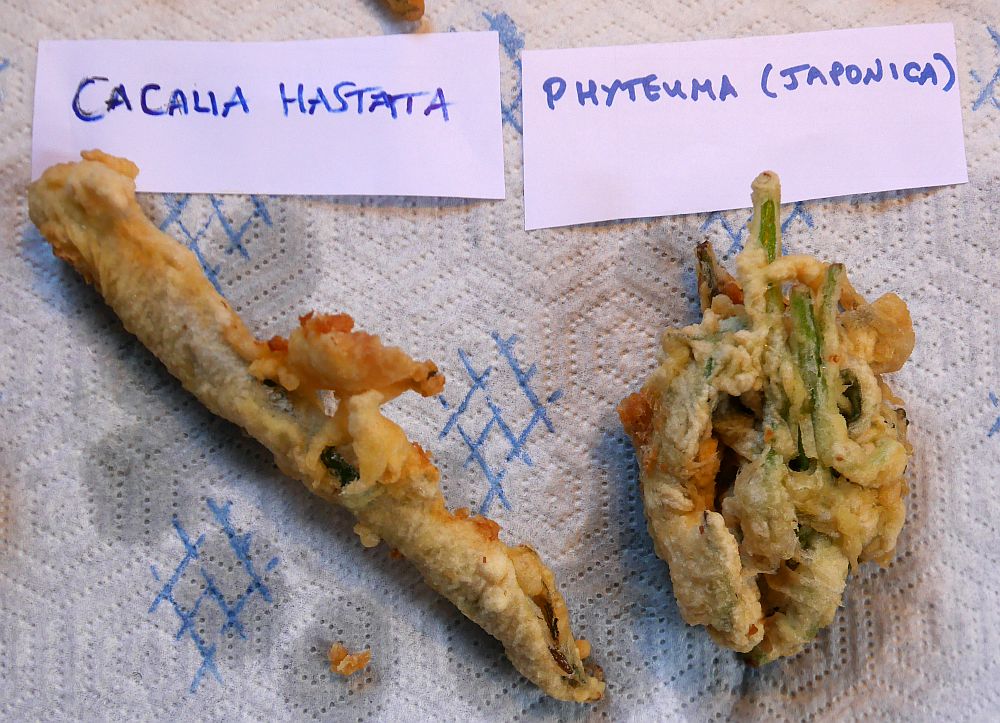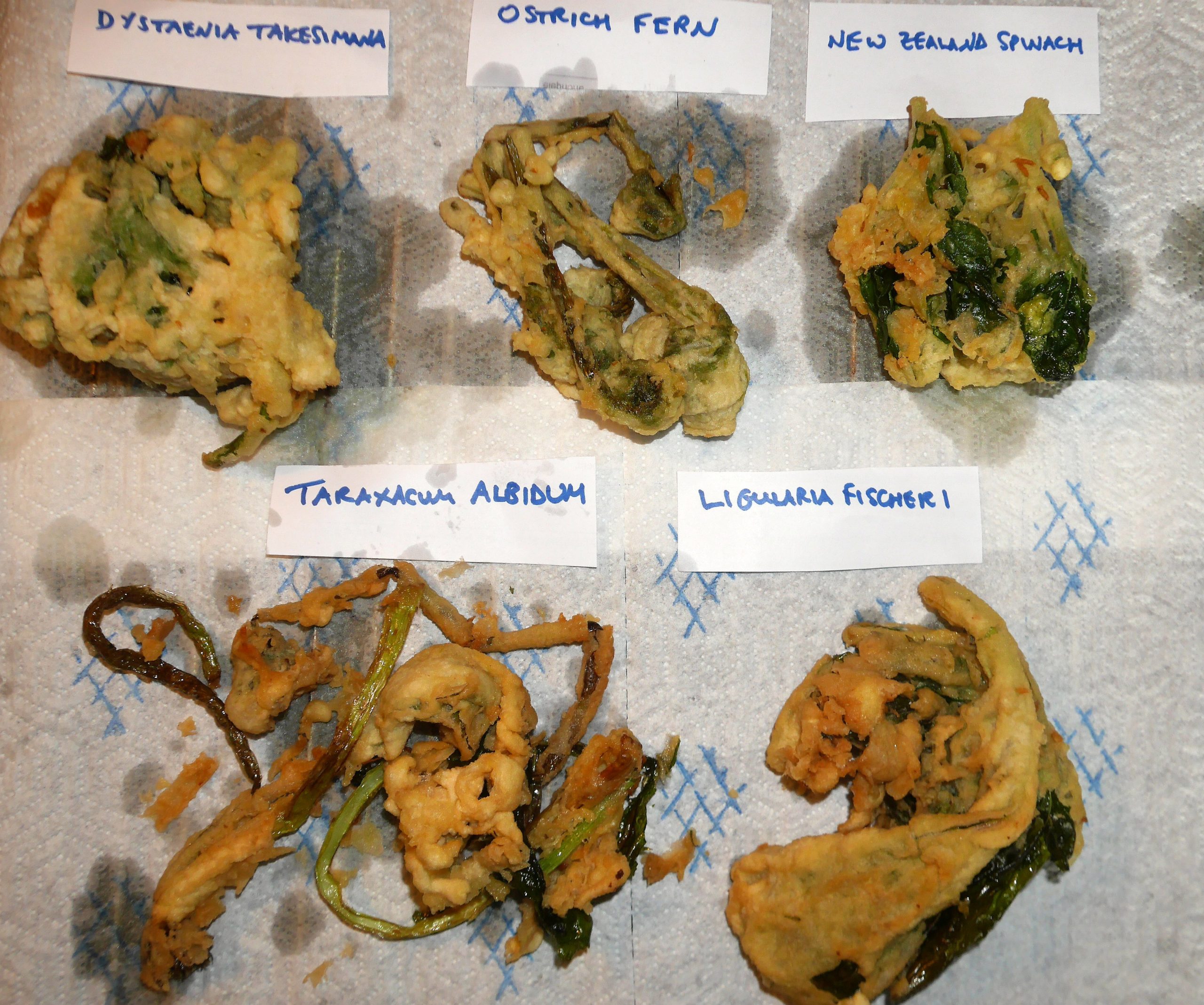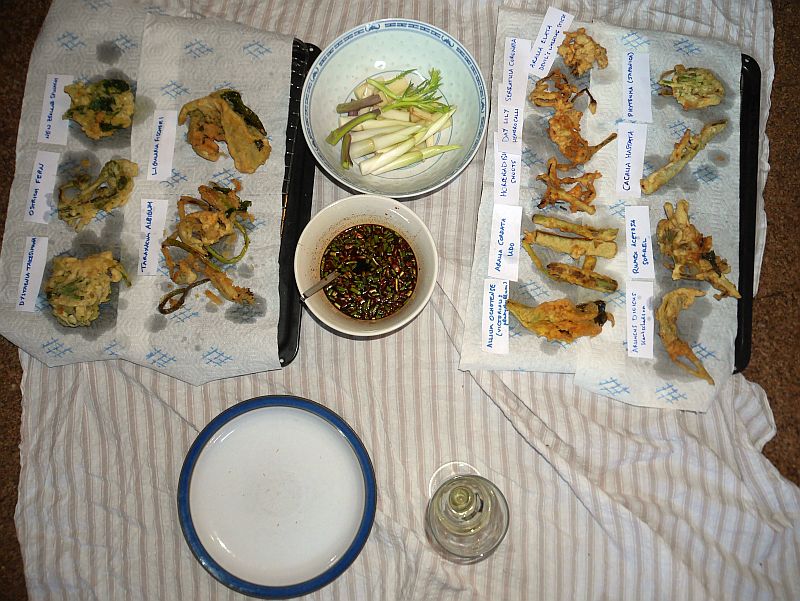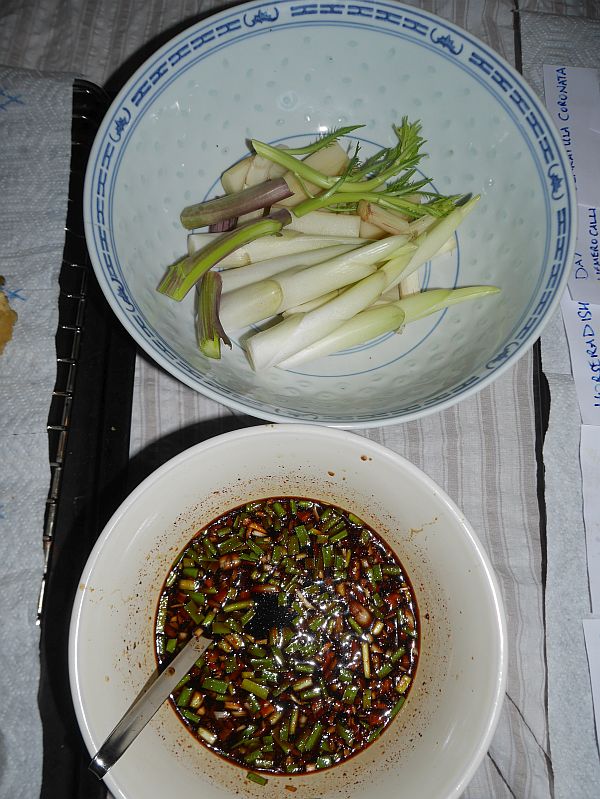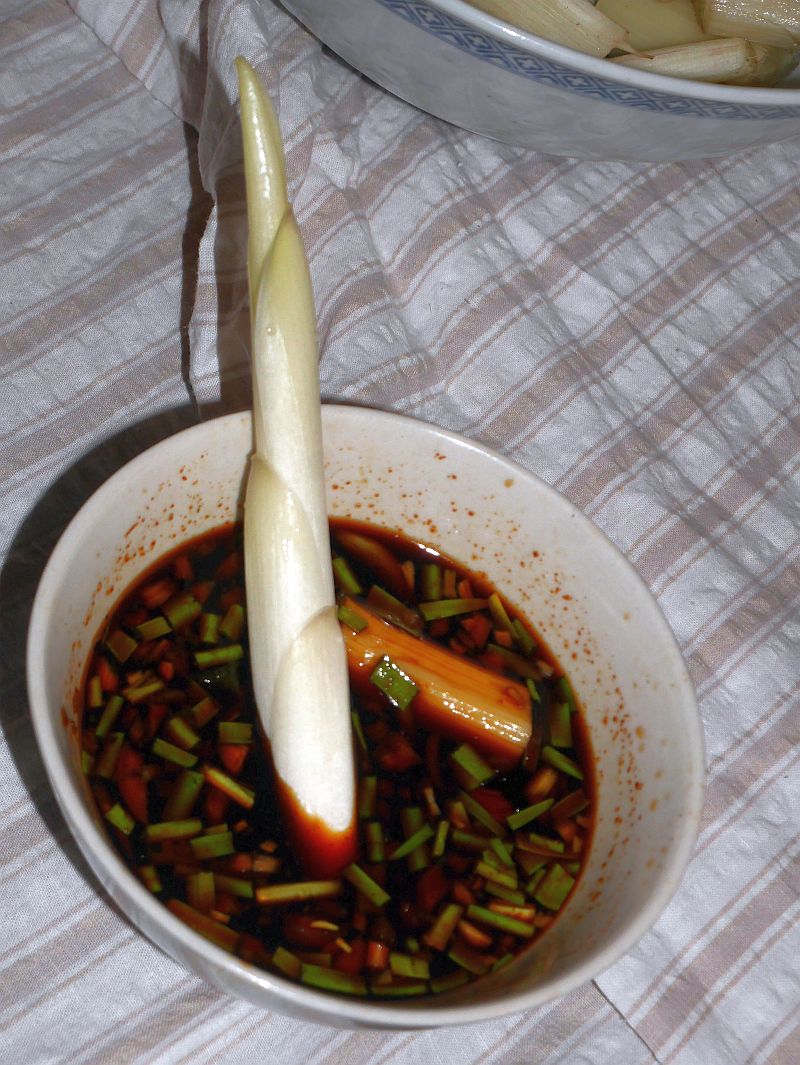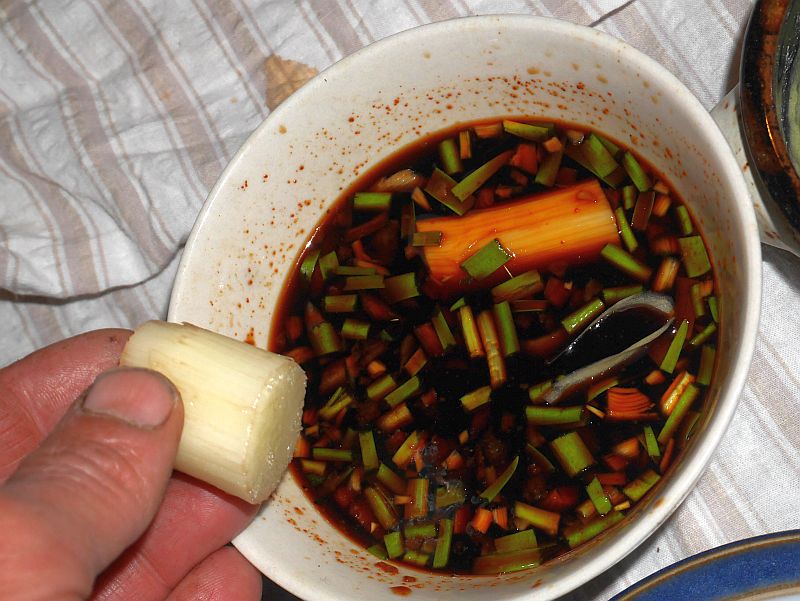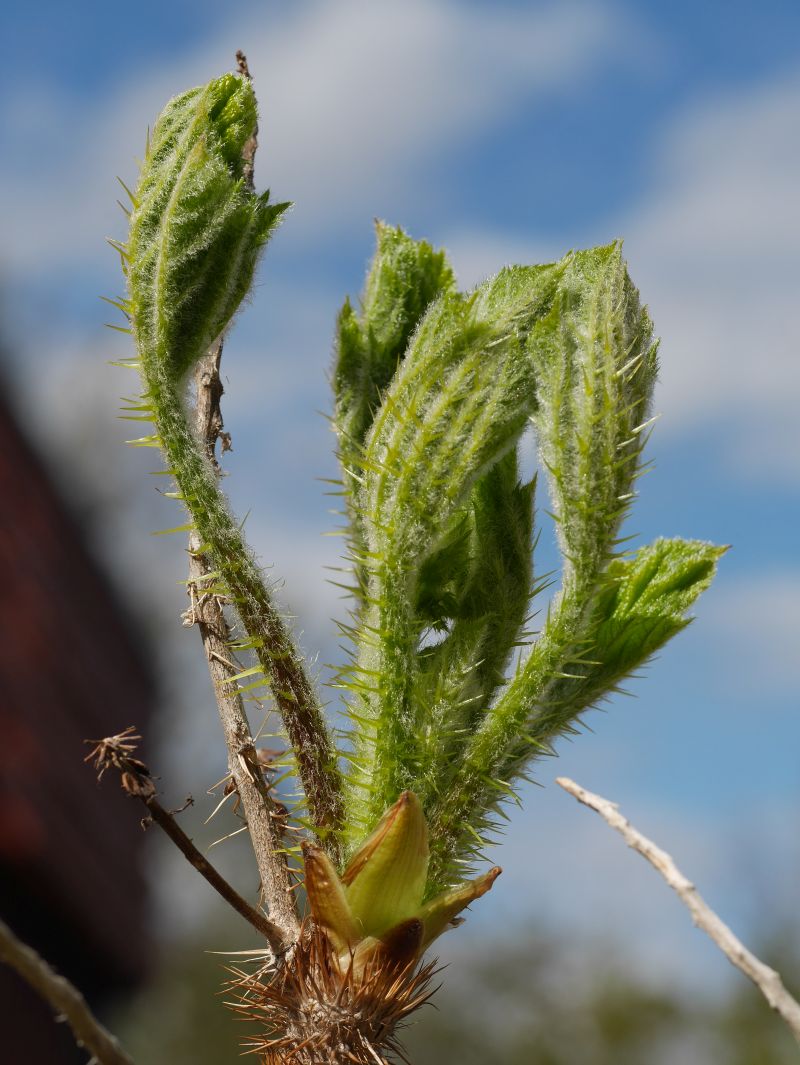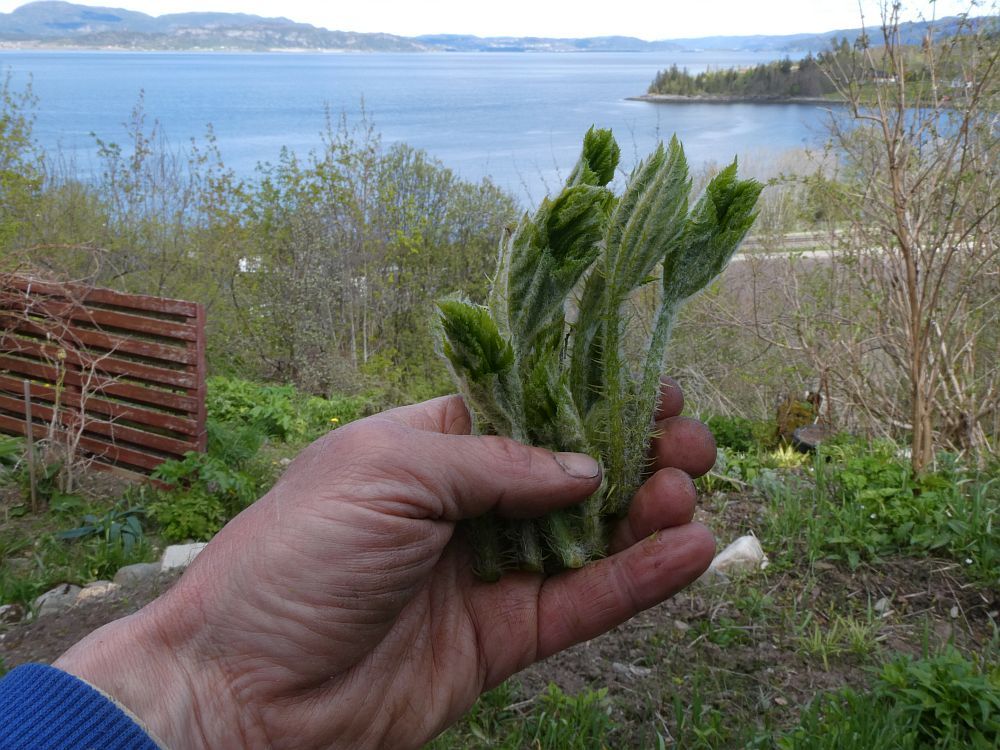Last night’s greens included all my 16 Hostas, Allium scorodoprasum (sand leek / bendelløk) scapes; broccolis from sea kale (strandkål), ornamental sea kale (Crambe cordifolia) and Turkish rocket (Bunias orientalis); and flower buds of two daylilies Hemerocallis lilioasphodelus and Hemerocallis dumortieri!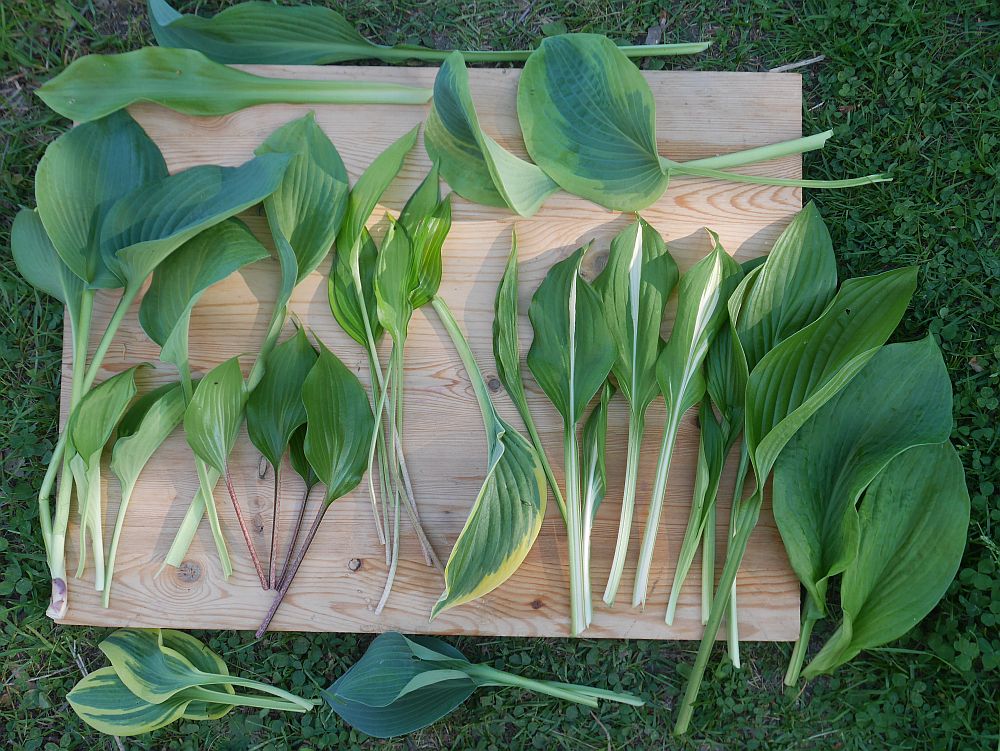

Category Archives: Perennial vegetables
Sustainable kales
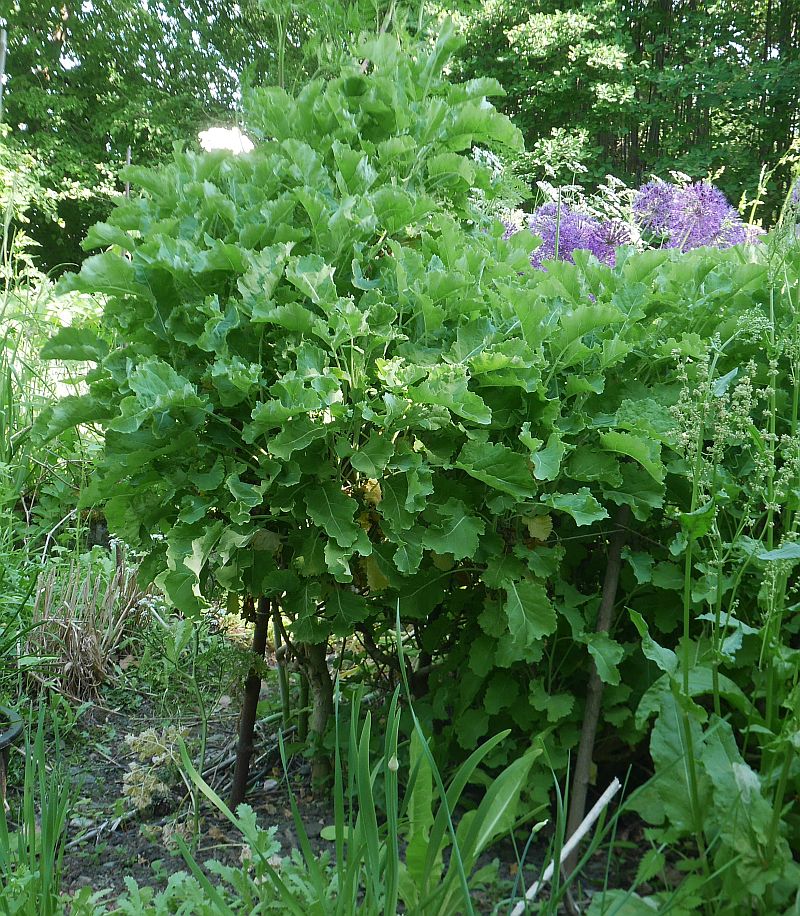
A few days ago the plague of Brassica growers, diamond back moth (kålmøll) arrived in significant numbers here and I see on various FB groups that folk are using floating mulch and enviromesh to protect their crops. I had done the same for years, but decided that I wanted to grow vegetables without non-sustainable oil based products like Agryl fleece which is no doubt also a major source of plastic fibres in nature. Agryl is also used to bring on annual crops earlier. However, there is an alternative plastic free and sustainable alternative using perennials. As you can see, my kales having grown for two and a half months are large and have been providing kale leaves since early spring. Their main growth period is now over but will be resumed in autumn. Although diamond back moths and other butterflies lay their eggs on these kales damage isn’t significant. Therefore I am totally unworried by this invasion of moths!
Norwegian quinoa and swamp greens medley
13th June 2020 perennial greens were stir-fried and served with quinoa and served with Allium ursinum flowers.
Allium validum (swamp or Pacific onion) with flower shoot
Saxifraga pensylvanica (swamp saxifrage)
Gunnera tinctoria
Asparagus officinalis (asparges)
Crambe maritima (sea kale / strandkål broccolis)
Perennial kale “Walsall Allotments” (flerårig kål)
Campanula latifolia (giant bellflower / storklokke)
Aster macrophyllus (big-leaf aster)
flowering shoots of various Russian Rumex acetosa cultivars (sorrel / engsyre)
The greens were stir-fried with chili and garlic and served with Norwegian organic quinoa with ramsons (ramsløk) flowers:


SO/TR Pizza
I have a feeling that no one else had this pizza last night! SO/TR? Sherpa Onion/Turkish Rocket of course, better known (to the botanist) as AW/BO or Allium wallichii/Bunias orientalis two of my June perennial vegetables, the young shoots of the onion (one of the latest Alliums to show it’s still alive in the spring) and the delicious broccolis of Turkish rocket. We turned it into pizza as we were making Danish sourdough rye bread (using the 24 hour bake at 70C method) and had made extra dough.
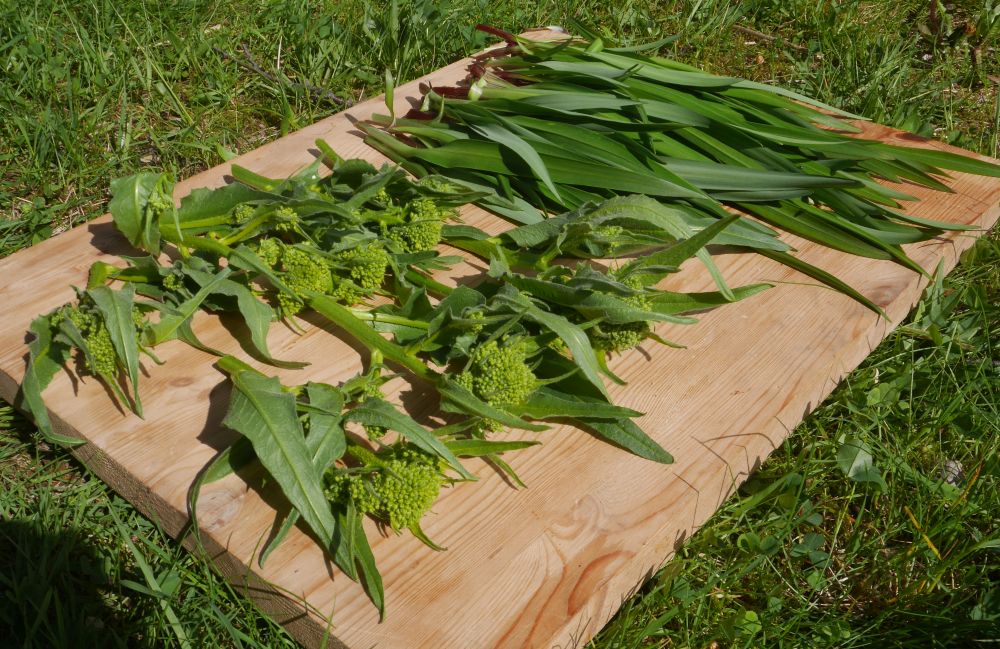
Hablitzia: from seed to flowering in 4 months
I’ve often noted that Hablitzia plants grow slowly the first year or so, but under ideal conditions (more warmth than we get outdoors here) they can grow fast…
I sowed seed in February, stratifying first for 10 days in the fridge and they germinated quickly in the living room. I grew them on indoors (it was too cold to put them out) and for lack of space I planted together with newly planted taro (Colocasia esculenta) tubers in a large pot. They grew quickly and they were about to start flowering yesterday when I dug up the plants and moved outside!

Hablitzia as a weed!
Hablitzia as a weed!
While researching Hablitzia tamnoides for my book Around the World in 80 plants (2014) I found the following simple entry in a 19th century encyclopedia of ornamental plants: ![]() The author was clearly not impressed…..
The author was clearly not impressed…..
Further Frederik Christian Schübeler (1815-1892) who was professor of botany and manager of the Oslo botanical garden at Toyen in Oslo from 1866-92 also noted from northern Norway that
“At Maalselvdalens Vicarage (69 deg. 10 min. N), where it also grows very well, it reaches 8 feet (2.5m) and doesn’t only give mature seeds, but spreads even in the garden as a weed.”
I found this difficult to believe and thought initially that it had been confused with good king Henry (Chenopodium bonus-henricus) which can be very weedy in a garden. I only had one plant at the time and I struggled to get more than a couple of seeds from it. Introducing a second plant, suddenly there was a lot of seed and seedlings appeared around the mother plants.
Nowadays it appears in many parts of the cultivated parts of my garden spread by the low friction seeds blowing around on ice in the winter and through my compost. Small plants often turn up as a weed in pot plants indoors which have been fed with compost. This is a plant which germinated in a pot with a bay tree (Laurus nobilis) some years ago. When the bay died, I let the Hablitzia grow on and it now uses the bay as a climbing frame!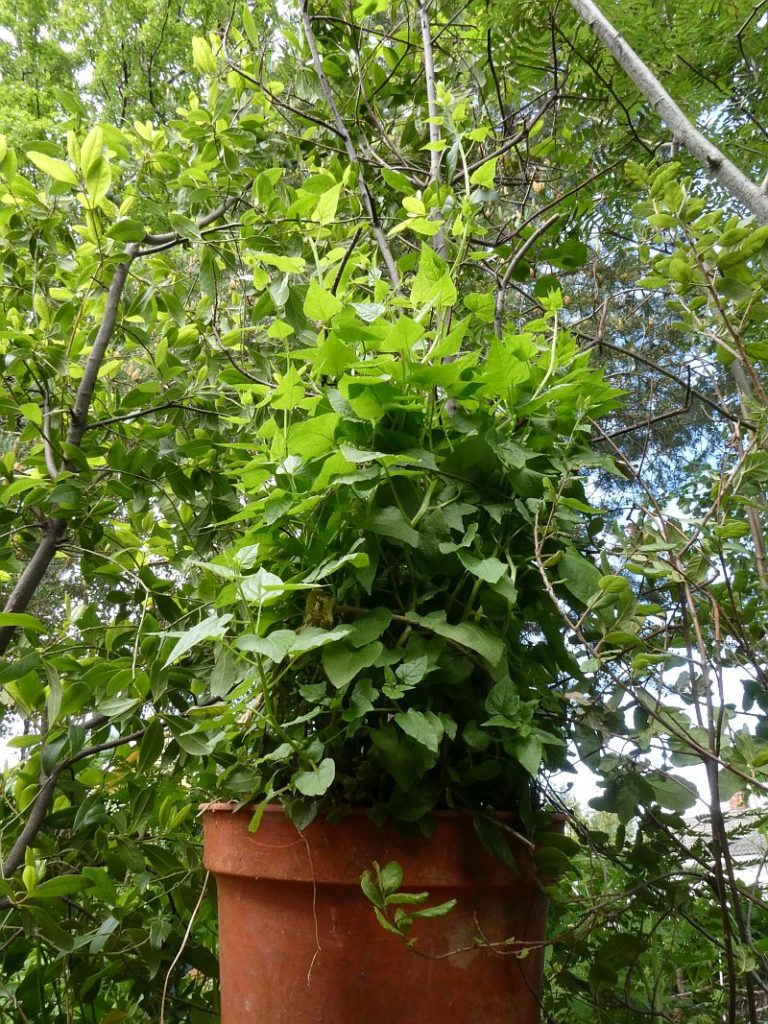
Nevertheless, Hablitzia seems to depend on naked earth to establish itself here and there are no reports of it escaping into nature approaching 150 years after its introduction as a garden plant here.
Yesterday, I was weeding Hablitzia from newly emerged carrot seedlings!
Veggie rich pie
AROUND THE WORLD IN THE EDIBLE GARDEN; Part 3 – Southern Europe and the Mediterranean countries
Inviting you to the third in a series of dinners from Malvik’s Edible Garden where we “forage” from different parts of the world!
If you’ve visited countries in south east Europe you will no doubt have eaten the delicious vegetable pies like Greek spanakopoita, Turkish börek, Italian Torta pasqualina, Bulgarian banitsa and others. Inspired by these and not wanting to make the time consuming to make filo pastry, we made a 100% wholegrain rye/barley quiche like dish with large quantities of the following perennial greens: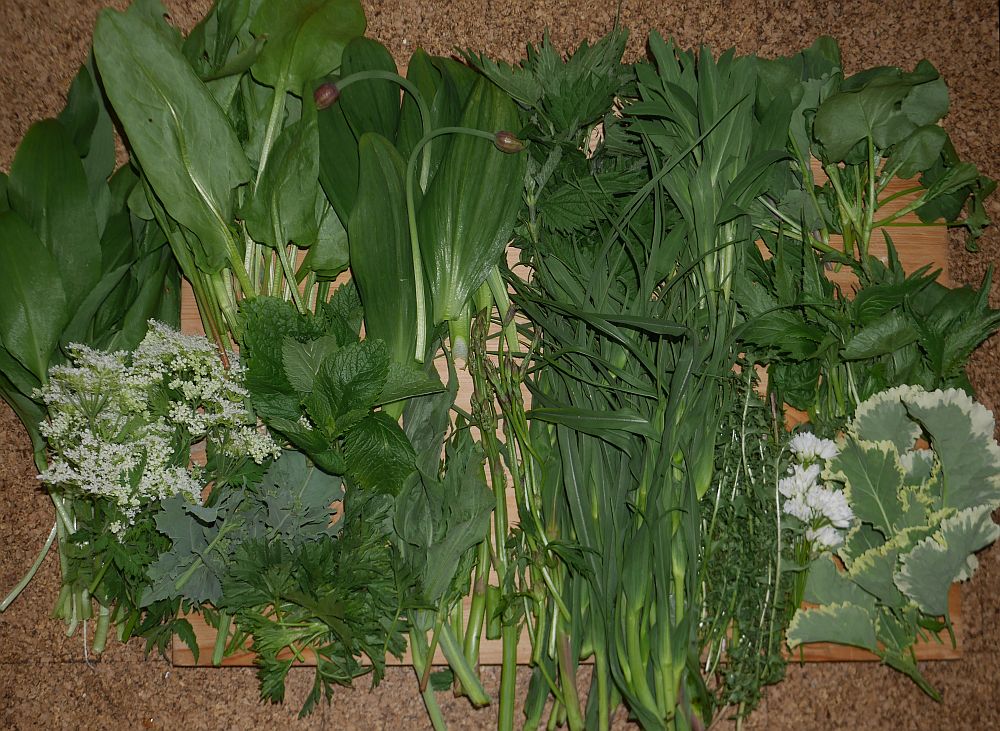
From left to right (from top left) :
Allium ursinum (ramsons; ramsløk)
Rumex patientia (patience dock; hagesyre)
Urtica dioica (stinging nettle; brennesle)
Silene vulgaris (bladder campion; engsmelle)
Rumex scutatus (Buckler-leaved sorrel; Fransksyre)
Rumex acetosa (sorrel; engsyre)
Myrrhis odorata (sweet cicely; Spansk kjørvel)
Malva alcea (hollyhock mallow; rosekattost)
Melissa officinalis (lemon balm; sitronmelisse)
Scorzonera hispanica (Scorzonera; scorsonnerot, svartrot)
Asparagus officinalis (asparagus; asparges)
Humulus lupulus (hops; humle)
Tragopogon pratensis (Jack-go-to-bed-at-noon; geitskjegg)
Taraxacum “Moss-leaved dandelion”
Campanula trachelium (nettle-leaved bellflower; nesleklokke)
Brassica oleracea “Daubenton variegated” (perennial kale; flerårige kål)
Allium zebdanense (white flowers) from Lebanon
(with garlic and chili and imported olives)
Garden wild green soup
Last night we made a green pea soup and apart from the Hablitzia (Caucasian spinach / stjernemelde), I used perennial vegetables growing in a wild part of the garden. With little or no help from me there’s a bounty of wild edibles in this area under wild hazels (Corylus avellana) and this made for a delicious pea soup with masses of greens.
Campanula latifolia is documented as used in spring soups in the 16th century in my area in Norway and Heracleum shoots are also a tradional soup ingredient, in particular Russian borsch now thought of as a beetroot soup was originally made with hogweed shoots.
Japanese white dandelion
My Taraxacum albidum is looking good at the moment!
The seed for this came from the Scottish Rock Gardening Club seed list 2016/17 (SRGC3660) and I planted two plants here. However, they look different in that the leaf shape is different (T. albidum is described as having deeply indented leaves) and only one has hairy scapes (as T. albidum). I suspect some crossing has been going on.
T albidum is itself a hybrid between white flowered Taraxacum coreanum and Taraxacum japonicum.
Korean tempura and dipping sauce for perennial vegetables
AROUND THE WORLD IN THE EDIBLE GARDEN; Part 2 – Korea
Inviting you to the second in a series of dinners from Malvik’s Edible Garden where we “forage” from different parts of the world!
We don’t often eat oily food, but now and again its great and this meal was exceptional!
From top left and clockwise:
Ligularia fischeri
Dystaenia takesimana (Giant Ulleung celery, seombadi)
Aralia cordata (udo) (blanched for dipping and green for tempura)
Phyteuma (should have been japonica, but I used nigra; svartvadderot)
Allium victorialis subsp platyphyllum (victory onion; seiersløk)
Aralia elata (devil’s walking stick, fandens spaserstokk)
Hosta “Frances Williams”
Hemerocallis dumortieri (flower shoots) (dayliliy, daglilje)
Parasenecio hastatus (also the first time I ate this one and it was delicious, but I wouldn’t advise eating a lot: see here http://www.edimentals.com/blog/?p=23845)
Matteuccia struthiopteris “Jumbo” (ostrich fern; strutseving)
Taraxacum albidum and to the right of this:
New Zealand spinach and
Serratula coronata (also a first for me; the subspecies insularis is eaten in the Far East)
Oplopanax horridus (North American species substituting Asian species Oplopanax japonicus or Oplopanax elatus)
More information with the pictures!

